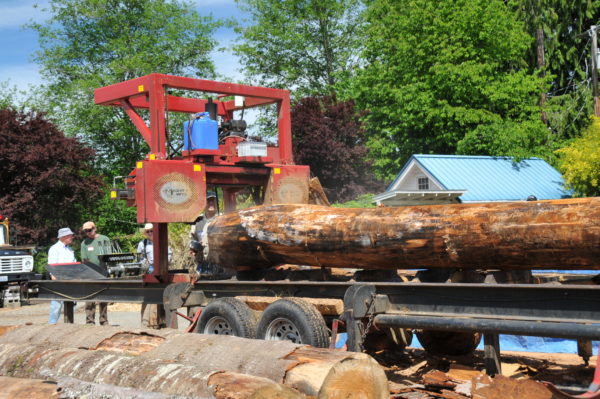NNRG / Northwest Certified Forestry organized another interesting and educational workshop for small-scale woodland owners, this time at the beautiful 150 acre Wild Thyme Farm in Oakville. There was a large turnout of people from across Washington and Oregon. The information and discussions kept flowing all day from both the instructors and the participants. We also learned about the Forest Stewardship Council (FSC) wood sustainability certification process in action, agroforestry, permaculture design, and ongoing economic wood harvesting within a context of preserving the overall forest and habitat.
Workshop presentations included: understanding log / wood qualities, small-scale sawmilling, sawing for value versus volume, small-scale drying techniques, preparing green lumber for drying, avoiding common drying defects, niche marketing of wood products lumber grading and measuring, and a walking tour of the farm and its facilities.
There were some important learning items for me, that apply to our project:
- Logs: Using logs in the construction of our home is going to be more difficult than I had hoped. The ideal was to be able to slowly air dry them onsite and save them for later as large whole log structural supports. However, several experts at the workshop were concerned about damage over time by insects, rot inside due to the extremely slow drying times of thick wood, and high likelihood of checking/cracking. Darn. I was hoping to move ahead earlier on logging in the area of the home site, to keep the project momentum moving forward. However, it appears that if I want to use whole logs in the construction process I should wait until near construction time and have them kiln dried. That complicates things by increasing the schedule interdependencies, but it does reduce some near term complexity since I do not even have a house design yet and so am not yet sure what timber I need to keep onsite.
- Radio frequency drying: There is apparently a new drying technology where lumber is dried by radio waves, which essentially are longer length than microwaves but think of it as a big microwave oven. This approach can prevent drying related defects and may be a good option for logs. However, there are a very limited number of kilns with this technology and it is more expensive than regular kiln drying.
- Air drying milled lumber: On a positive note, air drying milled lumber on site is a definite possibility if desired, though it can take (very roughly) a year per inch of thickness to dry and it may not get to the desired 8-10% moisture content level in a reasonable time period. Stacking lumber for air drying can be done it the lumber is of similar size at least a foot off the ground, has 3/4″+ stickers (wood separators) every 12-24″ between boards and vertically aligned up the stack, and is covered to protect from rain and snow but still allow air movement. Technical specifications and guideline handouts were provided in the course.



STAY INFORMED WITH OUR NEWSLETTER
SEARCH
CATEGORIES
ARCHIVES